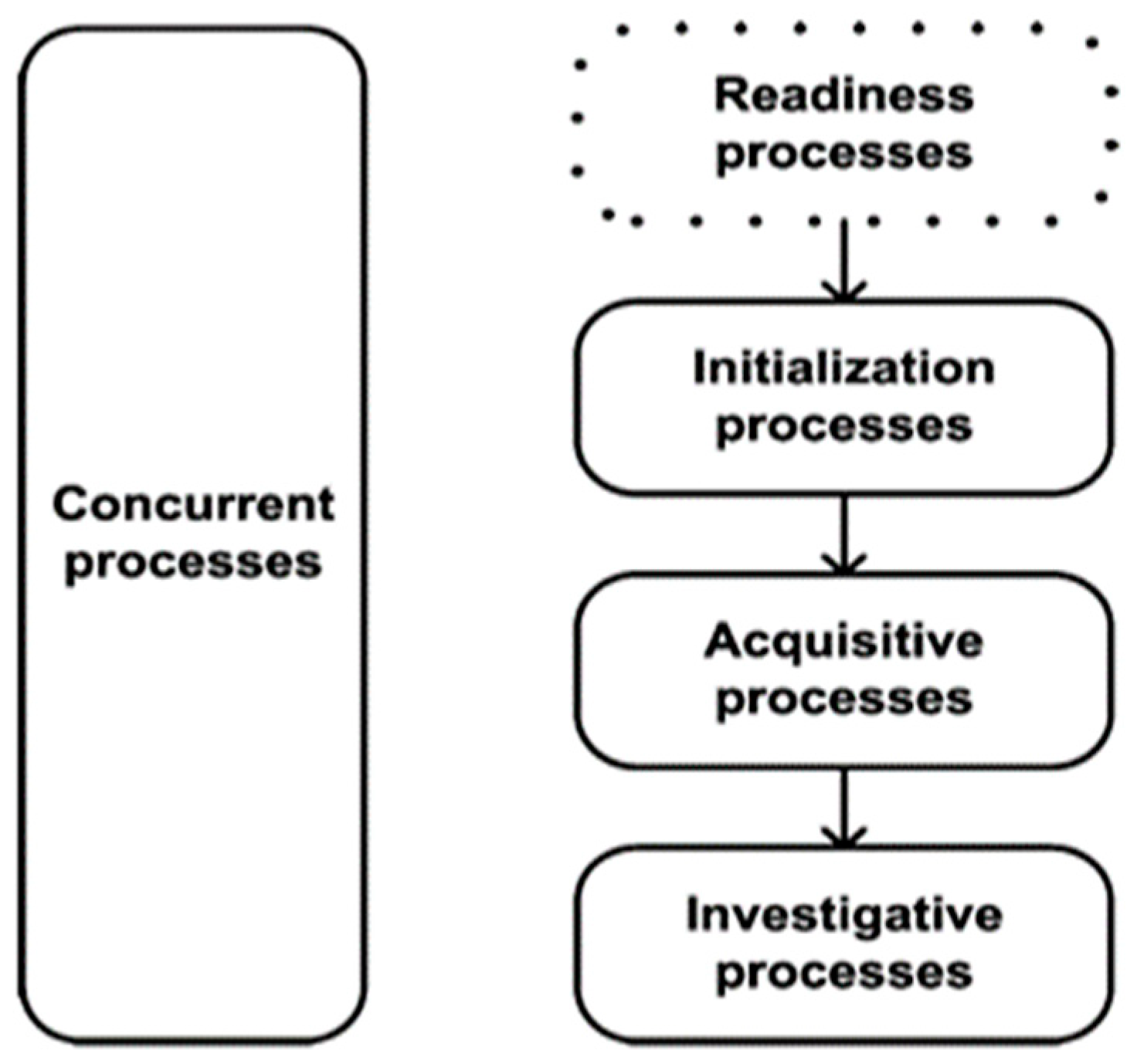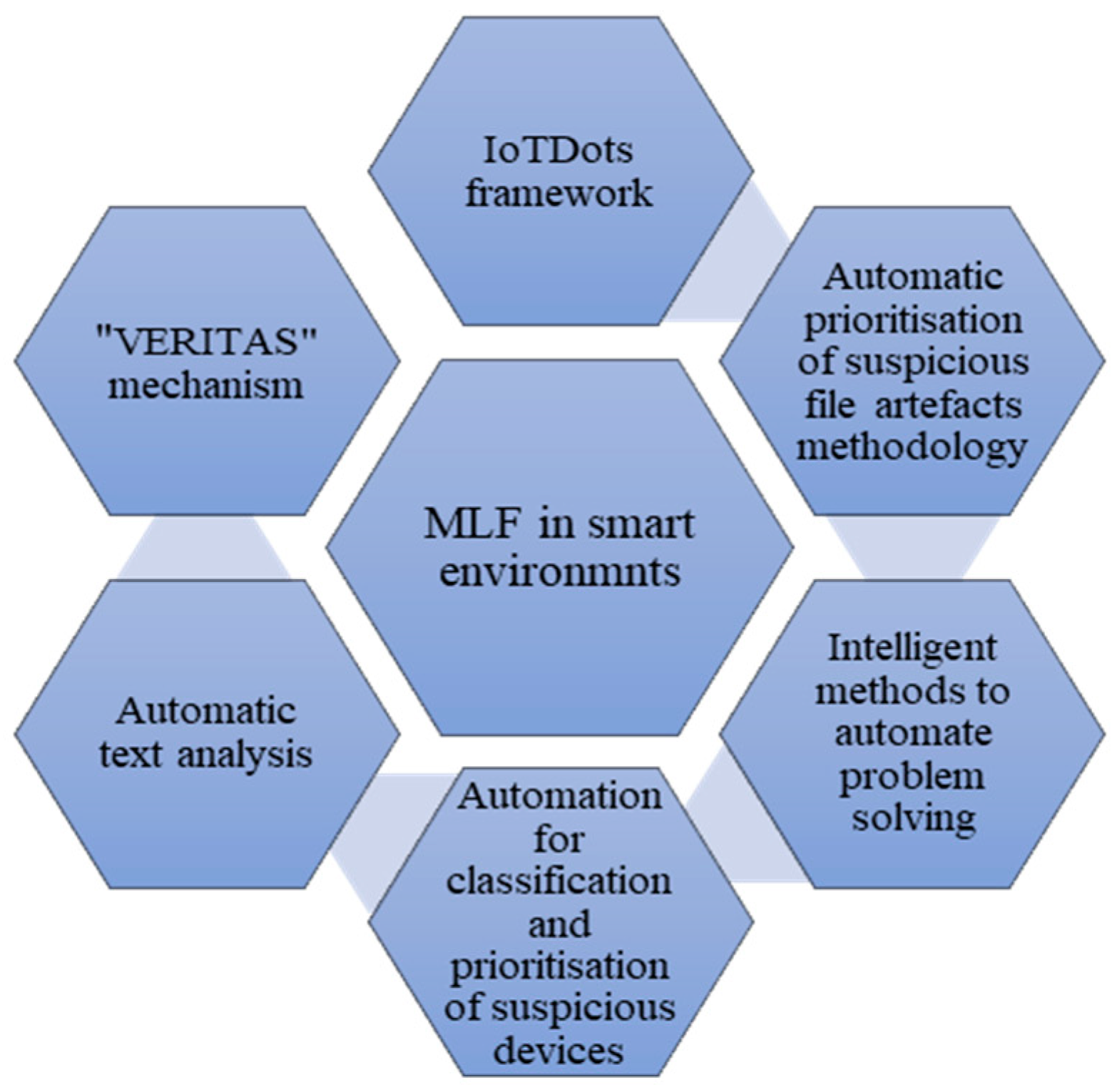Machine-Learning Forensics: State of the Art in the Use of Machine-Learning Techniques for Digital Forensic Investigations within Smart Environments
Abstract
:1. Introduction
2. Background
2.1. Digital Forensics (DF)
2.2. ISO/IEC 27043
2.3. Smart Environments
2.4. Machine Learning (ML)
3. State-of-the-Art Use of Machine-Learning Techniques in Digital Forensics
- The IoTDots framework was proposed as a solution to deal with the large amounts of data collected by IoT devices and sensors.
- Automatic prioritisation of suspicious file artefacts was proposed as a solution to deal with the growing volume of data and manual retrieval of suspicious files.
- Intelligent methods to automate problem-solving were proposed as a solution to deal with the massive amounts of data that must be analysed for digital evidence.
- Automation using ML techniques for classification and AI techniques for prioritising suspicious devices was proposed as a solution to deal with the growing number of cases needing DF competence and the large volumes of data to be processed.
- Automatic text analysis to detect online sexual predatory talks was proposed as a solution to deal with the growth of cybercrime targeting minors, the large volume of data, and the DFI process, which is done primarily by hand.
- The “VERITAS” mechanism to automatically collect and extract forensic evidence from smart environments was proposed as a solution to deal with the large amounts of data that is generated in smart environments.
- An intelligent intrusion detection system to detect regular and malicious attacks on data created in smart environments was proposed as a solution to deal with the simple and complex attacks that face IoT networks in particular.
- A blockchain-assisted shared audit framework for identifying data-scavenging attacks in virtualised resources was proposed as a solution to deal with attack and violation detection in smart environments.
- An intelligent forensic analysis mechanism was proposed as a solution to deal with the probability of continual attacks on IoT devices and the low processing power and memory of these devices.
4. The Impact of MLF on the DFI Process
5. Conclusions
Author Contributions
Funding
Institutional Review Board Statement
Informed Consent Statement
Data Availability Statement
Conflicts of Interest
References
- Popescul, D.; Radu, L.D. Data Security in Smart Cities: Challenges and Solutions. Inform. Econ. 2016, 20, 29–38. [Google Scholar] [CrossRef]
- Quick, D.; Choo, K.-K.R. Big forensic data management in heterogeneous distributed systems: Quick analysis of multimedia forensic data. Software Pract. Exp. 2016, 47, 1095–1109. [Google Scholar] [CrossRef]
- Watson, S.; Dehghantanha, A. Digital forensics: The missing piece of the Internet of Things promise. Comput. Fraud. Secur. 2016, 2016, 5–8. [Google Scholar] [CrossRef]
- Du, X.; Hargreaves, C.; Sheppard, J.; Anda, F.; Sayakkara, A.; Le-Khac, N.A.; Scanlon, M. SoK. In Proceedings of the 15th International Conference on Availability, Reliability and Security, Virtual, 25–28 August 2020. [Google Scholar] [CrossRef]
- Babun, L.; Sikder, A.; Acar, A.; Uluagac, A. IoTDots: A Digital Forensics Framework for Smart Environments. arXiv 2022, arXiv:1809.00745. Available online: https://arxiv.org/abs/1809.00745 (accessed on 1 March 2023).
- Kebande, V.R.; Ikuesan, R.A.; Karie, N.M.; Alawadi, S.; Choo, K.-K.R.; Al-Dhaqm, A. Quantifying the need for supervised machine learning in conducting live forensic analysis of emergent configurations (ECO) in IoT environments. Forensic Sci. Int. Rep. 2020, 2, 100122. [Google Scholar] [CrossRef]
- Valjarevic, A.; Venter, H.S. A Comprehensive and Harmonized Digital Forensic Investigation Process Model. J. Forensic Sci. 2015, 60, 1467–1483. [Google Scholar] [CrossRef]
- Conti, M.; Dehghantanha, A.; Franke, K.; Watson, S. Internet of Things security and forensics: Challenges and opportunities. Futur. Gener. Comput. Syst. 2018, 78, 544–546. [Google Scholar] [CrossRef]
- Valjarevic, A.; Venter, H.; Petrovic, R. ISO/IEC 27043:2015—Role and application. In Proceedings of the 2016 IEEE 24th Telecommunications Forum (TELFOR), Belgrade, Serbia, 22–23 November 2016; pp. 1–4. [Google Scholar] [CrossRef]
- Tok, Y.C.; Chattopadhyay, S. Identifying threats, cybercrime and digital forensic opportunities in Smart City Infrastructure via threat modeling. Forensic Sci. Int. Digit. Investig. 2023, 45, 301540. [Google Scholar] [CrossRef]
- Sahib, H.I.; AlSudani, M.Q.; Ali, M.H.; Abbas, H.Q.; Moorthy, K.; Adnan, M.M. Proposed intelligence systems based on digital Forensics: Review paper. Mater. Today Proc. 2023, 80, 2647–2651. [Google Scholar] [CrossRef]
- Qadir, A.M.; Varol, A. The role of machine learning in Digital Forensics. In Proceedings of the 2020 8th International Symposium on Digital Forensics and Security (ISDFS), Beirut, Lebanon, 1–2 June 2020. [Google Scholar] [CrossRef]
- Goni, I.; Gumpy, J.M.; Maigari, T.U.; Muhammad, M.; Saidu, A. Cybersecurity and Cyber Forensics: Machine Learning Approach. Mach. Learn. Res. 2020, 5, 46. [Google Scholar] [CrossRef]
- Iqbal, S.; Alharbi, S.A. Advancing Automation in Digital Forensic Investigations Using Machine Learning Forensics. Digit. Forensic Sci. 2020. [Google Scholar] [CrossRef]
- Jarrett, A.; Choo, K.R. The impact of automation and artificial intelligence on digital forensics. WIREs Forensic Sci. 2021, 3, e1418. [Google Scholar] [CrossRef]
- Du, X.; Scanlon, M. Methodology for the automated metadata-based classification of incriminating digital forensic artefacts. In Proceedings of the 14th International Conference on Availability, Reliability and Security, Canterbury, UK, 26–29 August 2019; pp. 1–8. Available online: https://bit.ly/2Oqh6u6 (accessed on 9 March 2023).
- Krivchenkov, A.; Misnevs, B.; Pavlyuk, D. Intelligent Methods in Digital Forensics: State of the Art. In Lecture Notes in Networks and Systems; Springer: Berlin/Heidelberg, Germany, 2019; pp. 274–284. [Google Scholar] [CrossRef]
- Babun, L.; Sikder, A.; Acar, A.; Uluagac, S. The Truth Shall Set Thee Free: Enabling Practical Forensic Capabilities in Smart Environments. In Proceedings of the 2022 Network and Distributed System Security Symposium, San Diego, CA, USA, 24–28 April 2022. [Google Scholar] [CrossRef]
- Shakeel, P.M.; Baskar, S.; Fouad, H.; Manogaran, G.; Saravanan, V.; Montenegro-Marin, C.E. Internet of things forensic data analysis using machine learning to identify roots of data scavenging. Futur. Gener. Comput. Syst. 2021, 115, 756–768. [Google Scholar] [CrossRef]
- Adam, I.Y.; Varol, C. Intelligence in digital forensics process. In Proceedings of the 2020 8th International Symposium on Digital Forensics and Security (ISDFS), Beirut, Lebanon, 1–2 June 2020. [Google Scholar] [CrossRef]
- Ngejane, C.; Eloff, J.; Sefara, T.; Marivate, V. Digital forensics supported by machine learning for the detection of online sexual predatory chats. Forensic Sci. Int. Digit. Investig. 2021, 36, 301109. [Google Scholar] [CrossRef]
- Kalnoor, G.; Gowrishankar, S. IoT-based smart environment using intelligent intrusion detection system. Soft Comput. 2021, 25, 11573–11588. [Google Scholar] [CrossRef]
- Mazhar, M.S.; Saleem, Y.; Almogren, A.; Arshad, J.; Jaffery, M.H.; Rehman, A.U.; Shafiq, M.; Hamam, H. Forensic Analysis on Internet of Things (IoT) Device Using Machine-to-Machine (M2M) Framework. Electronics 2022, 11, 1126. [Google Scholar] [CrossRef]
- Koroniotis, N.; Moustafa, N.; Slay, J. A new Intelligent Satellite Deep Learning Network Forensic framework for smart satellite networks. Comput. Electr. Eng. 2022, 99, 107745. [Google Scholar] [CrossRef]
- Palmese, F.; Redondi, A.E.; Cesana, M. Feature-Sniffer: Enabling IoT Forensics in OpenWrt based Wi-Fi Access Points. arXiv 2023, arXiv:2302.06991. Available online: https://arxiv.org/abs/2302.06991 (accessed on 5 June 2023).
- Salih, K.M.M.; Dabagh, N.B.I. Digital Forensic Tools: A Literature Review. J. Educ. Sci. 2023, 32, 109–124. [Google Scholar] [CrossRef]
- Shahbazi, Z.; Byun, Y.-C. NLP-Based Digital Forensic Analysis for Online Social Network Based on System Security. Int. J. Environ. Res. Public Health 2022, 19, 7027. [Google Scholar] [CrossRef] [PubMed]
- Ferreira, S.; Antunes, M.; Correia, M.E. A Dataset of Photos and Videos for Digital Forensics Analysis Using Machine Learning Processing. Data 2021, 6, 87. [Google Scholar] [CrossRef]
- Balushi, Y.A.; Shaker, H.; Kumar, B. The use of machine learning in digital forensics: Review paper. In Proceedings of the 1st International Conference on Innovation in Information Technology and Business (ICIITB 2022); Atlantis Press: Amsterdam, The Netherlands, 2023; pp. 96–113. [Google Scholar] [CrossRef]
- Baig, Z.; Khan, M.A.; Mohammad, N.; Ben Brahim, G. Drone Forensics and Machine Learning: Sustaining the Investigation Process. Sustainability 2022, 14, 4861. [Google Scholar] [CrossRef]



| Reference No. | Used ML Technique | Readiness Processes | Initialisation Processes | Acquisitive Processes | Investigative Processes | Concurrent Processes |
|---|---|---|---|---|---|---|
| [5] | Markov chain model | X | ||||
| [6] | Supervised machine learning | X | X | |||
| [16] | Supervised machine learning | X | ||||
| [17] | Unsupervised identification | X | X | |||
| [18] | Markov chain model | X | ||||
| [19] | Logical regression | X | X | |||
| [21] | Logistic regression | X | ||||
| [22] | Markov chain model | X | ||||
| [23] | Decision-tree algorithm | X |
Disclaimer/Publisher’s Note: The statements, opinions and data contained in all publications are solely those of the individual author(s) and contributor(s) and not of MDPI and/or the editor(s). MDPI and/or the editor(s) disclaim responsibility for any injury to people or property resulting from any ideas, methods, instructions or products referred to in the content. |
© 2023 by the authors. Licensee MDPI, Basel, Switzerland. This article is an open access article distributed under the terms and conditions of the Creative Commons Attribution (CC BY) license (https://creativecommons.org/licenses/by/4.0/).
Share and Cite
Tageldin, L.; Venter, H. Machine-Learning Forensics: State of the Art in the Use of Machine-Learning Techniques for Digital Forensic Investigations within Smart Environments. Appl. Sci. 2023, 13, 10169. https://doi.org/10.3390/app131810169
Tageldin L, Venter H. Machine-Learning Forensics: State of the Art in the Use of Machine-Learning Techniques for Digital Forensic Investigations within Smart Environments. Applied Sciences. 2023; 13(18):10169. https://doi.org/10.3390/app131810169
Chicago/Turabian StyleTageldin, Laila, and Hein Venter. 2023. "Machine-Learning Forensics: State of the Art in the Use of Machine-Learning Techniques for Digital Forensic Investigations within Smart Environments" Applied Sciences 13, no. 18: 10169. https://doi.org/10.3390/app131810169
APA StyleTageldin, L., & Venter, H. (2023). Machine-Learning Forensics: State of the Art in the Use of Machine-Learning Techniques for Digital Forensic Investigations within Smart Environments. Applied Sciences, 13(18), 10169. https://doi.org/10.3390/app131810169







